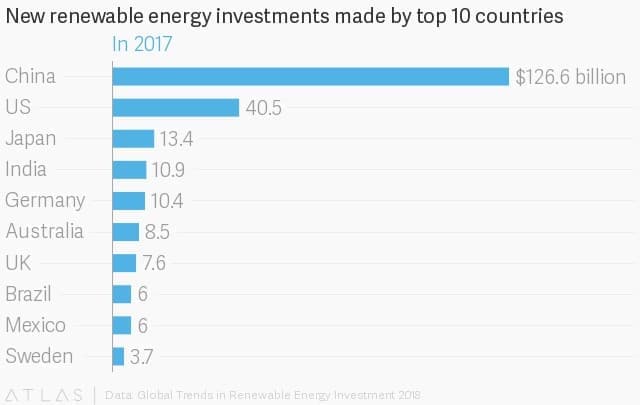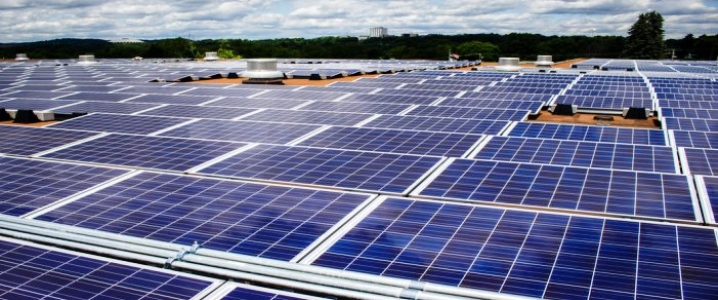More than a decade ago, China overtook the U.S. as the world's biggest carbon dioxide emitter. Today, it’s going for a complete 360 with a hungry drive to beat the United States at the renewable energy game.
After all, this is largely a technology game, and China hopes to be the global technology leader, according to its strategic state plan by 2030. And in many ways, Beijing is winning the game.
China is now the largest investor in solar energy. In fact, according to the New York Times, the country is putting up new power generation projects so fast that substations that would connect them to the grid aren’t keeping pace.
Now, the solar freeways are the next gambit because they take the ‘farm’ out of solar and free up the land for agricultural use.
Led by a company called Pavenergy, in partnership with state-owned interstate construction firm Qilu Transportation, China is fast-tracking the country’s first solar highway in Jinan, the capital city of the eastern Shandong Province.
The plastic-covered solar panels cover a portion of highway that is two-thirds of a mile long and is designed to absorb the pressure of some 45,000 cars and trucks that traverse it daily.
And this patch of highway is close to an electricity substation, so it can be hooked up to the grid easily. It also runs through and around cities, so nothing is lost along the way. It’s all captured for power.
In the United States, the prospect of a solar highway is decidedly more complicated.
Related: Trump’s Ultimate Move To Lower Gasoline Prices
With the exception of a smattering of bridges and specific sections of some interstate highways, American roads just won’t cut it: They’re asphalt heavy and they give just enough for solar panels to snap, according to one transportation engineering professor from the University of Texas, cited by the New York Times. But Chinese roads generally have a heavy concrete foundation.
But it may be prohibitively expensive in either venue. It’s definitely more expensive than asphalt.
But it’s about production volume. In China’s case, Pavenergy is hoping it can bring the cost down to around $300 per square meter from the now-exorbitant $460 per square meter for a solar road. They also argue that they would have to be replaced less frequently than asphalt currently requires.
They also argue that it could eventually pay for itself by producing around $15 of electricity per square meter of solar panel—per year. That doesn’t sound like much, but a Chinese professor told NYT that it would mean that within 15 years it would pay for itself.
As we read about yet another way in which China is one-upping the United States on the technological battlefield, the war is not likely to be won through solar highways—one of the most complicated feats in renewable energy due to the cost of installation, questions about efficiency, and repairs.
But the pace of investment in renewables is still staggering.
The thing about China’s solar highway is this: Costs will come down once adoption becomes widespread, and the Chinese are the kings of forced, strategic adoption. In China, renewable energy gets invested and implemented before it makes any sense. In the United States, the reverse is true.
According to Bloomberg New Energy Finance, nearly half of the world’s new renewable energy investment of $279.8 billion last year came from China. Beijing’s investment in renewable energy (for everything except hydro projects) jumped 30 percent in 2017 from the previous year.
And it definitively outpaced U.S. investment by three times. In the U.S., investment in renewables even fell 6 percent in 2017, dropping to $40.5 billion.

(Click to enlarge)
The game is on, and the winner will be the one willing to spend loads of cash on projects, even when it’s not immediately economically viable.
By Damir Kaletovic for Oilprice.com
More Top Reads From Oilprice.com:
- Chinese Oil Demand Growth Could Slow Down Soon
- Goldman: Brent To Retest $80 This Year
- U.S. Poised To Ease Biofuel Quotas



















1. If there are vehicles on the road, output is reduced. Because cars and trucks block sunlight, the more of them using the road the less power you will get from it. This may come as a shock, but roads are all about having cars and trucks drive on them.
2. It will be impossible to keep them in good enough shape for reasonable output and you will spend a lot of money trying. You are talking about at least weekly washing, and not with your generic street sweeper, which would leave them nearly opaque with smeared dirt and cloudy water. But never mind; the "plastic-covered" top surface will be opaque in a year or less anyway. Think about salt, sand, brake lining dust, leaked auto fluids and ordinary everyday grit worked on by ceaseless car tires grinding them all into the road. Think about a snow plow doing its thing.
3. You could get far more bang for your buck putting your panels almost ANYWHERE else. You could buy multiple times the number of panels for the same price and install them where they would actually receive good sunlight and produce power. Why would anyone with an economic stake choose such a bizarre option?
4. If you are intent on marrying solar with roads, build structures over the road and mount the solar on those structures; far more output, far less maintenance and longer panel life, and probably cheaper. You also gain the benefit of always dry roads that last longer, with no need for snow removal in the winter.
I'm sure that in six months or so there will be yet another article about how someone just built a half mile of solar road somewhere and they are "testing it", and how it's the biggest thing since sliced bread and IT WILL STILL NOT BE A THING; just another bad idea that refuses to die.
Put solar panels over a road that cars don't actually move. Let's call it a parking lot. That way when the cars are sitting there they will be in the nice shade. Could even make them EVs and have charge points that come directly from the solar panels.
Based on all data presented, seems like it'd more appropriate to say the "game is already over"